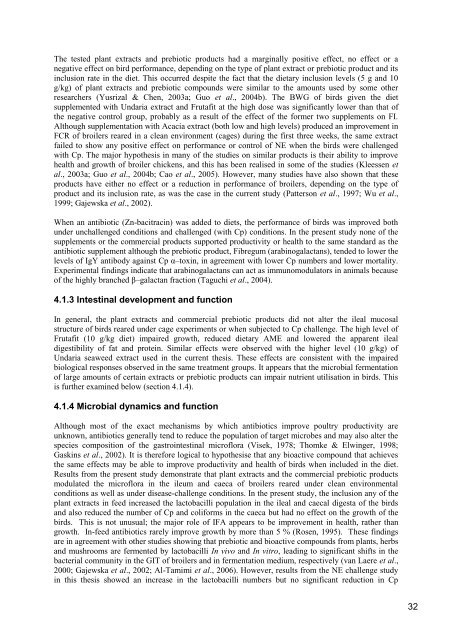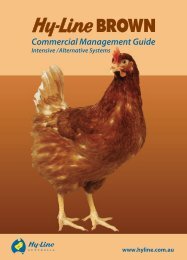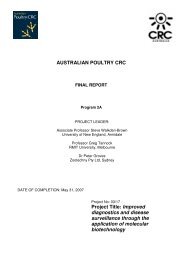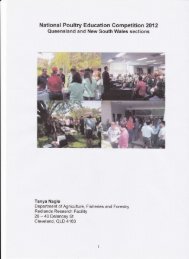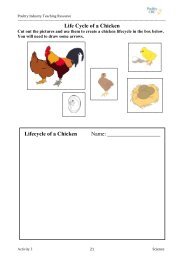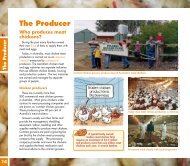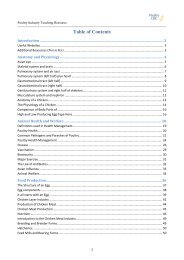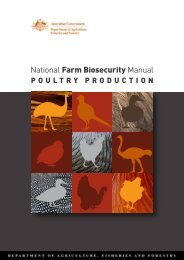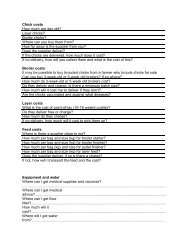You also want an ePaper? Increase the reach of your titles
YUMPU automatically turns print PDFs into web optimized ePapers that Google loves.
The tested plant extracts and prebiotic products had a marginally positive effect, no effect or anegative effect on bird performance, depending on the type of plant extract or prebiotic product and itsinclusion rate in the diet. This occurred despite the fact that the dietary inclusion levels (5 g and 10g/kg) of plant extracts and prebiotic compounds were similar to the amounts used by some otherresearchers (Yusrizal & Chen, 2003a; Guo et al., 2004b). The BWG of birds given the dietsupplemented with Undaria extract and Frutafit at the high dose was significantly lower than that ofthe negative control group, probably as a result of the effect of the former two supplements on FI.Although supplementation with Acacia extract (both low and high levels) produced an improvement inFCR of broilers reared in a clean environment (cages) during the first three weeks, the same extractfailed to show any positive effect on performance or control of NE when the birds were challengedwith Cp. The major hypothesis in many of the studies on similar products is their ability to improvehealth and growth of broiler chickens, and this has been realised in some of the studies (Kleessen etal., 2003a; Guo et al., 2004b; Cao et al., 2005). However, many studies have also shown that theseproducts have either no effect or a reduction in performance of broilers, depending on the type ofproduct and its inclusion rate, as was the case in the current study (Patterson et al., 1997; Wu et al.,1999; Gajewska et al., 2002).When an antibiotic (Zn-bacitracin) was added to diets, the performance of birds was improved bothunder unchallenged conditions and challenged (with Cp) conditions. In the present study none of thesupplements or the commercial products supported productivity or health to the same standard as theantibiotic supplement although the prebiotic product, Fibregum (arabinogalactans), tended to lower thelevels of IgY antibody against Cp α–toxin, in agreement with lower Cp numbers and lower mortality.Experimental findings indicate that arabinogalactans can act as immunomodulators in animals becauseof the highly branched β–galactan fraction (Taguchi et al., 2004).4.1.3 Intestinal development and functionIn general, the plant extracts and commercial prebiotic products did not alter the ileal mucosalstructure of birds reared under cage experiments or when subjected to Cp challenge. The high level ofFrutafit (10 g/kg diet) impaired growth, reduced dietary AME and lowered the apparent ilealdigestibility of fat and protein. Similar effects were observed with the higher level (10 g/kg) ofUndaria seaweed extract used in the current thesis. These effects are consistent with the impairedbiological responses observed in the same treatment groups. It appears that the microbial fermentationof large amounts of certain extracts or prebiotic products can impair nutrient utilisation in birds. Thisis further examined below (section 4.1.4).4.1.4 Microbial dynamics and functionAlthough most of the exact mechanisms by which antibiotics improve poultry productivity areunknown, antibiotics generally tend to reduce the population of target microbes and may also alter thespecies composition of the gastrointestinal microflora (Visek, 1978; Thomke & Elwinger, 1998;Gaskins et al., 2002). It is therefore logical to hypothesise that any bioactive compound that achievesthe same effects may be able to improve productivity and health of birds when included in the diet.Results from the present study demonstrate that plant extracts and the commercial prebiotic productsmodulated the microflora in the ileum and caeca of broilers reared under clean environmentalconditions as well as under disease-challenge conditions. In the present study, the inclusion any of theplant extracts in feed increased the lactobacilli population in the ileal and caecal digesta of the birdsand also reduced the number of Cp and coliforms in the caeca but had no effect on the growth of thebirds. This is not unusual; the major role of IFA appears to be improvement in health, rather thangrowth. In-feed antibiotics rarely improve growth by more than 5 % (Rosen, 1995). These findingsare in agreement with other studies showing that prebiotic and bioactive compounds from plants, herbsand mushrooms are fermented by lactobacilli In vivo and In vitro, leading to significant shifts in thebacterial community in the GIT of broilers and in fermentation medium, respectively (van Laere et al.,2000; Gajewska et al., 2002; Al-Tamimi et al., 2006). However, results from the NE challenge studyin this thesis showed an increase in the lactobacilli numbers but no significant reduction in Cp32


